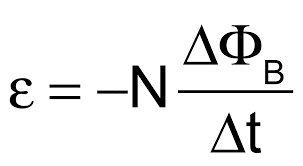Faraday's law of electromagnetic induction | Faraday's law of induction | Faraday's experiment.
Faraday's law of induction (briefly, Faraday's law) is a basic law of electromagnetism predicting how a magnetic field will interact with an electric circuit to produce an electromotive force (EMF)—a phenomenon known as electromagnetic induction. It is the fundamental operating principle of transformers, inductors, and many types of electrical motors, generators and solenoids.
The Maxwell–Faraday equation (listed as one of Maxwell's equations) describes the fact that a spatially varying (and also possibly time-varying, depending on how a magnetic field varies in time) electric field always accompanies a time-varying magnetic field, while Faraday's law states that there is EMF (electromotive force, defined as electromagnetic work done on a unit charge when it has traveled one round of a conductive loop) on the conductive loop when the magnetic flux through the surface enclosed by the loop varies in time.
Faraday's law had been discovered and one aspect of it (transformer EMF) was formulated as the Maxwell–Faraday equation later. The equation of Faraday's law can be derived by the Maxwell–Faraday equation (describing transformer EMF) and the Lorentz force (describing motional EMF). The integral form of the Maxwell–Faraday equation describes only the transformer EMF, while the equation of Faraday's law describes both the transformer EMF and the motional EMF.
Faraday’s Laws of Electromagnetic Induction
Faraday’s Laws of Electromagnetic Induction consists of two laws. The first law describes the induction of emf in a conductor, and the second law quantifies the emf produced in the conductor. In the following few sections, let us learn these laws in detail.
Faraday’s First Law of Electromagnetic Induction
The discovery and understanding of electromagnetic induction are based on a long series of experiments carried out by Faraday and Henry. From the experimental observations, Faraday concluded that an emf is induced when the magnetic flux across the coil changes with time. Therefore, Faraday’s first law of electromagnetic induction states the following:
Whenever a conductor is placed in a varying magnetic field, an electromotive force is induced. If the conductor circuit is closed, a current is induced, which is called induced current.
Mentioned here are a few ways to change the magnetic field intensity in a closed loop:
By rotating the coil relative to the magnet.
By moving the coil into or out of the magnetic field.
By changing the area of a coil placed in the magnetic field.
By moving a magnet towards or away from the coil.
Faraday’s Second Law of Electromagnetic Induction
Faraday’s second law of electromagnetic induction states that

The induced emf in a coil is equal to the rate of change of flux linkage.
The flux is the product of the number of turns in the coil and the flux associated with the coil. The formula of Faraday’s law is given below:
Where ε is the electromotive force, Φ is the magnetic flux, and N is the number of turns.
Lenz’s Law
The German physicist Heinrich Friedrich Lenz deduced a rule known as Lenz’s law that describes the polarity of the induced emf.
Lenz’s law states that “The polarity of induced emf is such that it tends to produce a current which opposes the change in magnetic flux that produced it.”
The negative sign in the formula represents this effect. Thus, the negative sign indicates that the induced emf's direction and the magnetic fields' direction have opposite signs.





.jpg)
No comments:
Post a Comment